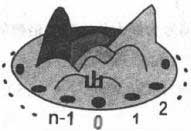ACM--steps--2.2.4--求最大公约数
2015-02-02 11:47
246 查看
Wolf and Rabbit |
| Time Limit: 2000/1000 MS (Java/Others) Memory Limit: 65536/32768 K (Java/Others) |
| Total Submission(s): 2020 Accepted Submission(s): 1145 |
| [align=left]Problem Description[/align] There is a hill with n holes around. The holes are signed from 0 to n-1.  A rabbit must hide in one of the holes. A wolf searches the rabbit in anticlockwise order. The first hole he get into is the one signed with 0. Then he will get into the hole every m holes. For example, m=2 and n=6, the wolf will get into the holes which are signed 0,2,4,0. If the rabbit hides in the hole which signed 1,3 or 5, she will survive. So we call these holes the safe holes. |
| [align=left]Input[/align] The input starts with a positive integer P which indicates the number of test cases. Then on the following P lines,each line consists 2 positive integer m and n(0<m,n<2147483648). |
| [align=left]Output[/align] For each input m n, if safe holes exist, you should output "YES", else output "NO" in a single line. |
[align=left]Sample Input[/align]2 1 2 2 2 |
[align=left]Sample Output[/align]NO YES |
| [align=left]Author[/align] weigang Lee 一开始想到Joseph。。。后来看了看,原来就是最大公约数的问题。 #include<iostream>
using namespace std;
bool dyx(int m,int n)
{
if(m>n)
{
m=m^n;
n=m^n;
m=m^n;
}
while(n%m)
{
int wyx=n%m;
n=m;
m=wyx;
}
return m==1?false:true;
}
int main()
{
int T;
cin>>T;
while(T--)
{
int m,n;
cin>>m>>n;
if(dyx(m,n))
cout<<"YES"<<endl;
else
cout<<"NO"<<endl;
}
return 0;
}<span style="color:#66ff99;">
</span> |
相关文章推荐
- 理工大学ACM平台题答案关于C语言 1131 C/C++经典程序训练1---最大公约数与最小公倍数
- ACM Open Judge:1.最大公约数和最小公倍数
- C语言求最小公倍数和最大公约数三种算法(经典)----ACM
- ACM--steps-3.2.5--Monkey and Banana//动态规划的最大子列和
- acm-求两数最大公约数和最小公倍数
- ACM 二进制求最大公约数 HDU5050
- ACM数论之旅3---最大公约数gcd和最小公倍数lcm(苦海无边,回头是岸( ̄∀ ̄))
- ACM--最大公约数--HDOJ 1019--Least Common Multiple--水
- hdu acm steps 2.2.4
- Java sdut acm 1131 CC++训练1---最大公约数与最小公倍数
- ACM学习历程20——竞赛中的简单数学问题之最大公约数、素数表、排列组合数
- ACM数论求最小公倍数(最大公约数)模板
- 杭电ACM1222——Wolf and Rabbit~~最大公约数
- 求两个数的最大公约数【ACM基础题】
- 山东理工大学ACM平台题答案关于C语言 1181 C语言实验——最小公倍数和最大公约数
- 山东理工大学ACM平台题答案关于C语言 1181 C语言实验——最小公倍数和最大公约数
- 学了acm才发现,最大公约数原来也有这么多性质
- ACM内部函数--数学问题--最大公约数最小公倍数
- 第十二周项目三——递归求两个数的最大公约数
- 做最大公约数有感
